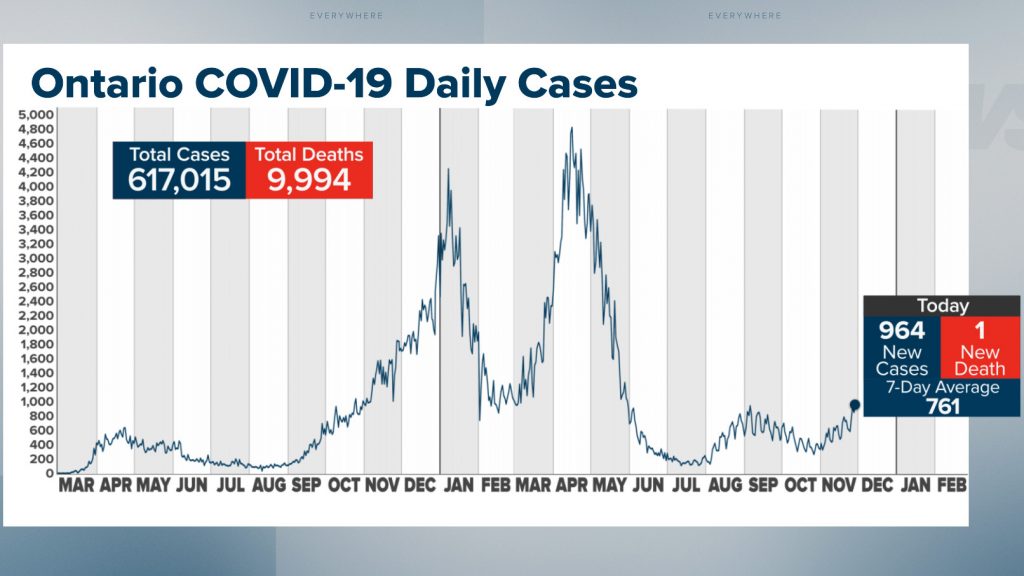Ontario reports just under 1,000 new COVID-19 cases, highest number since May

Posted November 28, 2021 10:05 am.
Last Updated November 28, 2021 4:33 pm.
Ontario is reporting 964 new COVID-19 cases on Sunday as daily infections continue their sharp growth as concerns mount over an emerging variant in South Africa.
One new death was recorded in the province.
Sunday’s daily figure is the highest in the province since May 30, when 1,033 cases were confirmed. The seven-day rolling average is now at 761 compared to 573 just under two weeks ago, and a low mark of 362 last seen on Nov. 1.
Of today’s new case count, Health Minister Christine Elliott says 519 involved unvaccinated individuals; 49 had an unknown vaccination status, while 396 were fully vaccinated.
“Individuals who are not fully vaccinated represent 23.6 per cent of Ontario’s total population,” Elliott tweeted.
There are 60 unvaccinated patients recovering from the virus in the ICU, with 83 unvaccinated individuals in the hospital. Eleven fully vaccinated patients are in the ICU presently, while 48 fully immunized individuals are in hospital with the virus.
Toronto’s public health unit once again reported over 100 new cases, with 129 confirmed in the city. It’s the first time Toronto has seen consecutive days with over 100 new cases since early October.
Elsewhere in the GTA, there are 60 new infections in York Region, 58 in Peel, 42 in Durham and 41 in Halton Regions.
Windsor-Essex has seen a recent increase in new daily cases with 86 infections on Sunday after reporting 57, 62 and 82 cases in each of the past three days. Simcoe Muskoka District recorded 81 new cases one day after seeing over 100 daily infections.
Provincial figures show 86.2 per cent of people aged 12 and older have received two doses of a COVID-19 vaccine and that the immunization of kids aged five to 11 continues to ramp up.
RELATED: More than 6,100 eligible kids vaccinated over first three days of Toronto campaign
As of Friday’s data, Ontario’s Science COVID-19 Science Advisory Table last reported an effective reproduction number R(t) of 1.10 in the province, which corresponds to the average number of additional infections caused by one case. An R(t) of greater than one indicates exponential growth.
Ontario’s R(t) has fluctuated lately, reaching a recent high point of 1.23 in early November. Its highest peak was between Aug. 6 to Aug. 12, when the province’s effective reproduction number came in at 1.43.
Ontario reported two more deaths linked to COVID-19 on Saturday.
The province also counted 854 new diagnoses — including 474 in people who aren’t fully vaccinated and 31 in people whose vaccination status isn’t known.
On Friday, Canada’s government introduced travel restrictions to help combat a disturbing new COVID-19 variant, dubbed omicron, first detected in southern Africa. This stemmed from Ontario Premier Doug Ford urging the feds to implement stringent measures to contain the variant through restricted air travel.
The new criteria put forth by federal officials are in effect immediately. They will ban the entry of foreign nationals who have visited seven southern African nations in the last two weeks.
Earlier, the Netherlands confirmed 13 cases of the new omicron variant on Sunday, and Australia found two as the countries half a world apart became the latest to detect it in travellers arriving from southern Africa.
With files from The Canadian Press and Michael Ranger of CityNews








